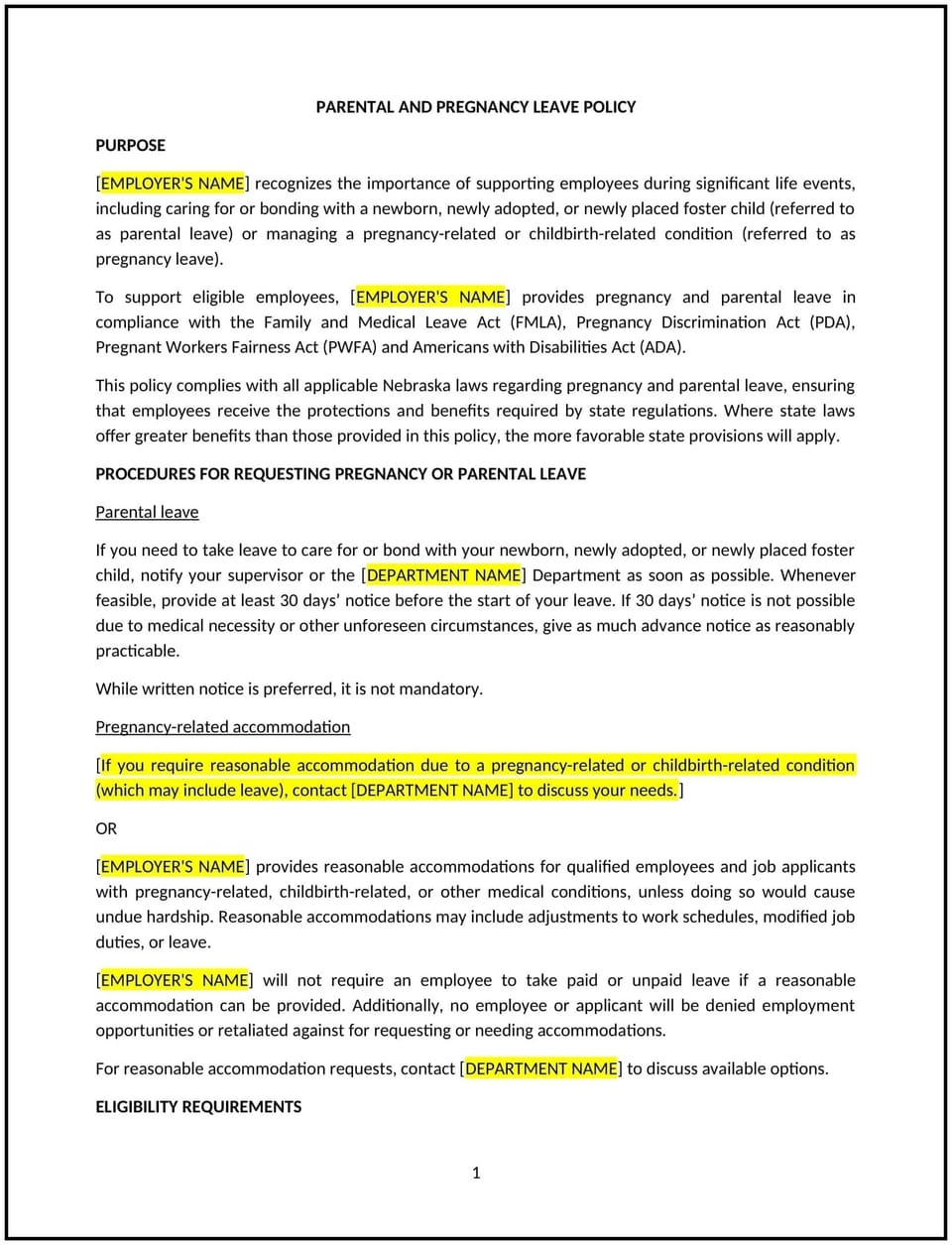Parental and pregnancy leave policy (Nebraska): Free template

Parental and pregnancy leave policy (Nebraska)
A parental and pregnancy leave policy helps Nebraska businesses support employees during significant life events, such as the birth or adoption of a child. This policy is designed to provide clear guidelines for leave eligibility, duration, and benefits, ensuring employees feel supported while maintaining business operations. Tailored to Nebraska’s workforce, this policy reflects the state’s values of family, community, and employee well-being.
By implementing this policy, businesses in Nebraska can foster a supportive workplace culture, improve employee retention, and demonstrate a commitment to work-life balance.
How to use this parental and pregnancy leave policy (Nebraska)
- Define eligibility: Specify which employees are eligible for parental and pregnancy leave, such as full-time or part-time staff.
- Outline leave types: Differentiate between pregnancy leave, parental leave, and adoption leave, including any specific requirements for each.
- Set leave duration: Provide clear guidelines on the length of leave available, including any legal minimums under federal or state law.
- Address paid vs. unpaid leave: Clarify whether leave is paid, unpaid, or a combination, and outline any available benefits or compensation.
- Establish notice requirements: Explain how employees should request leave, including advance notice and documentation.
- Coordinate with other policies: Ensure alignment with other leave policies, such as sick leave or FMLA, to avoid conflicts or gaps in coverage.
- Communicate the policy: Share the policy with employees during onboarding and through internal communications to ensure awareness and understanding.
- Train managers: Educate supervisors on how to handle leave requests fairly and consistently while maintaining business operations.
- Review and update the policy: Periodically assess the policy’s effectiveness and make adjustments as needed to reflect changes in laws or business needs.
Benefits of using this parental and pregnancy leave policy (Nebraska)
This policy offers several advantages for Nebraska businesses:
- Supports employee well-being: Providing leave for parental and pregnancy needs helps employees balance work and family responsibilities.
- Improves retention: A supportive leave policy can increase employee loyalty and reduce turnover.
- Enhances workplace culture: Demonstrating care for employees’ personal lives fosters a positive and inclusive work environment.
- Aligns with Nebraska values: The policy reflects the state’s emphasis on family, community, and employee support.
- Boosts morale: Employees are more likely to feel valued and motivated when their employer supports their personal needs.
- Attracts talent: A competitive leave policy can make the business more appealing to prospective employees.
- Reduces legal risks: Clear guidelines help businesses comply with federal and state leave laws, such as FMLA and Nebraska-specific regulations.
Tips for using this parental and pregnancy leave policy (Nebraska)
- Communicate the policy effectively: Share the policy with employees during onboarding and through regular reminders, such as emails or training sessions.
- Provide training: Educate managers on how to handle leave requests fairly and consistently while maintaining business operations.
- Offer flexibility: Consider allowing employees to use leave in increments or combine it with other types of leave, such as sick or vacation time.
- Document leave requests: Maintain records of all leave requests, approvals, and durations to ensure consistency and accountability.
- Support returning employees: Provide resources or accommodations to help employees transition back to work after leave.
- Review the policy periodically: Update the policy as needed to reflect changes in laws, employee needs, or business priorities.
- Lead by example: Ensure senior leadership demonstrates support for the policy and encourages a culture of work-life balance.
Q: Why should Nebraska businesses adopt a parental and pregnancy leave policy?
A: Businesses should adopt this policy to support employees during significant life events, improve retention, and foster a positive workplace culture.
Q: What types of leave should be included in the policy?
A: The policy should include pregnancy leave, parental leave, and adoption leave, with clear guidelines for each.
Q: How should businesses determine leave eligibility?
A: Businesses should define eligibility based on factors such as employment status (full-time or part-time) and length of service.
Q: What notice should employees provide for leave requests?
A: Employees should provide advance notice, typically 30 days, and submit any required documentation, such as medical certifications.
Q: Should businesses offer paid leave for parental and pregnancy purposes?
A: Businesses should consider offering paid leave or a combination of paid and unpaid leave to support employees financially during their time off.
Q: How can businesses handle leave requests fairly?
A: Businesses should train managers to handle requests consistently, document all leave decisions, and ensure compliance with federal and state laws.
Q: How often should businesses review the policy?
A: Businesses should review the policy annually or as needed to reflect changes in laws, employee needs, or business priorities.
This article contains general legal information and does not contain legal advice. Cobrief is not a law firm or a substitute for an attorney or law firm. The law is complex and changes often. For legal advice, please ask a lawyer.


